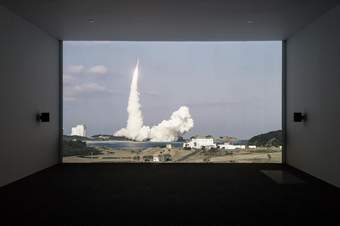Susan Norrie's work, often set in the Asia-Pacific, explores the relationship between technology and the environment and the complicity between global media and government.
In Transit 2011, Norrie shows the aftermath of the 2011 Tohoku earthquake in Japan and the tsunami which followed causing widespread flooding and the meltdown of the Fukushima Daiichi Nuclear Power Plant. An anti-nuclear demonstration shows the anger and frustration of people following the disaster, while the destructive power of nature is emphasised by a shot of the Sakurajima volcano erupting prior to the earthquake.
Collaborating with the scientists of the Japanese Aerospace Agency (JAXA), Norrie filmed rockets taking off from the island of Tanegashima carrying satellites to track weather patterns and global greenhouse emissions. On the island of Okinawa, Norrie filmed the night drill of the American airbase, which provides an ominous contrast to the predominant indigenous culture of the people living there.
Throughout Transit, Norrie uses the voice of a shaman, Yoshimaru Higa, as a way of providing a new perspective on man’s relationship with nature.
Tate, The Museum of Contemporary Art Australia (MCA) and Qantas are partners in an International Joint Acquisition Programme for contemporary Australian art. Susanne Norrie Transit 2011 was purchased jointly by Tate and the Museum of Contemporary Art Australia with fund provided by the Qantas Foundation, 2016.

